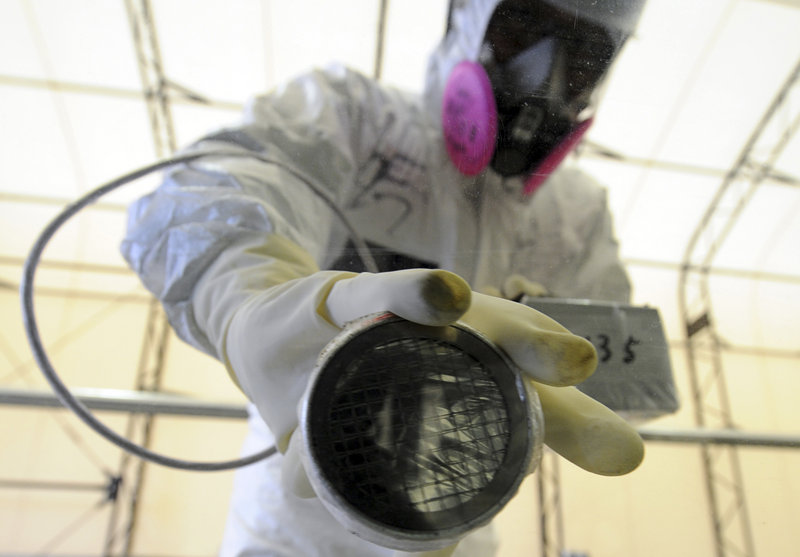TOKYO – The crippled nuclear plant at Fukushima is losing its two-year battle to contain radioactive water leaks, and its owner emphasized for the first time it needs overseas expertise to help contain the disaster.
Tokyo Electric Power Co. is grappling with the worst spill of contaminated water since the March 2011 earthquake and tsunami caused a meltdown at the Fukushima Dai-Ichi plant. The call for help from Zengo Aizawa, a vice president at the utility, follows a leak of 300 metric tons of irradiated water.
Japan’s nuclear regulator labeled the incident “serious” and questioned Tepco’s ability to deal with the crisis. Prime Minister Shinzo Abe made similar comments earlier this month.
“We will revamp contaminated-water management to tackle the issue at the Fukushima Dai-Ichi plant and seek expertise from within and outside of the country,” Aizawa said Wednesday in Tokyo. “There is much experience in decommissioning reactors outside of Japan. We need that knowledge and support.”
The International Atomic Energy Agency in Vienna and the U.S. Nuclear Regulatory Commission said they are prepared to help.
Tepco was storing 330,000 tons of radioactive water as of Aug. 13 in tanks covering an area equal to 37 football fields, according to the company. The utility is clearing forest to make room for more tanks as it adds to the stored water at a rate of 400 tons a day after pumping it out from under the plant’s reactors, which melted down as a result of the March 2011 earthquake and tsunami.
The water is treated to remove some of the cesium particles before it is stored, which has left 480 filters clogged with the radioactive material at the site. Each weigh 15 tons and are warehoused in what the utility calls temporary storage, although it will take hundreds of years for the radiation to decay. Other radioactive contaminants remain in the water even after treatment. They include strontium, which has been linked to bone cancers.
Besides radiated water, the site north of Tokyo has more than 73,000 cubic meters of contaminated concrete, 58,000 cubic meters of irradiated trees and undergrowth, and 157,710 gallons of toxic sludge, according to the utility.
Japan’s nuclear watchdog has ratcheted up alarm over the potential for more leaks of highly radioactive water from the hundreds of storage tanks at the Fukushima atomic plant.
The possibility of leaks from other tanks “is the biggest concern,” said Nuclear Regulation Authority Chairman Shunichi Tanaka. “This will need to be handled carefully on the assumption that one incident could bring another.”
Late Wednesday, Tepco said water leaking from the storage tank probably ran into the ocean, citing high radiation readings in a drainage ditch. As much as 20 trillion becquerels of cesium and 10 trillion becquerels of strontium leaked into the ocean since May 2011, Tepco spokeswoman Mayumi Yoshida said Thursday. The total amount of cesium and strontium is equivalent to about 100 times the annual limit on radiation from the plant to the ocean under normal conditions, according to calculations based on Tepco data.
The release is about a million times less than the contaminants spilled into the world’s oceans after nuclear bomb tests in the 1950s and ’60s, said Peter Burns, a radiation physicist based in Melbourne, who was formerly Australia’s representative on the United Nations’ committee on the effects of atomic radiation.
Radiation levels are rapidly diluted by the ocean and should pose few hazards outside of the harbor that is directly receiving the contaminants, said Kathryn Higley, a radiation health physicist at Oregon State University in Corvallis.
Send questions/comments to the editors.



Success. Please wait for the page to reload. If the page does not reload within 5 seconds, please refresh the page.
Enter your email and password to access comments.
Hi, to comment on stories you must . This profile is in addition to your subscription and website login.
Already have a commenting profile? .
Invalid username/password.
Please check your email to confirm and complete your registration.
Only subscribers are eligible to post comments. Please subscribe or login first for digital access. Here’s why.
Use the form below to reset your password. When you've submitted your account email, we will send an email with a reset code.